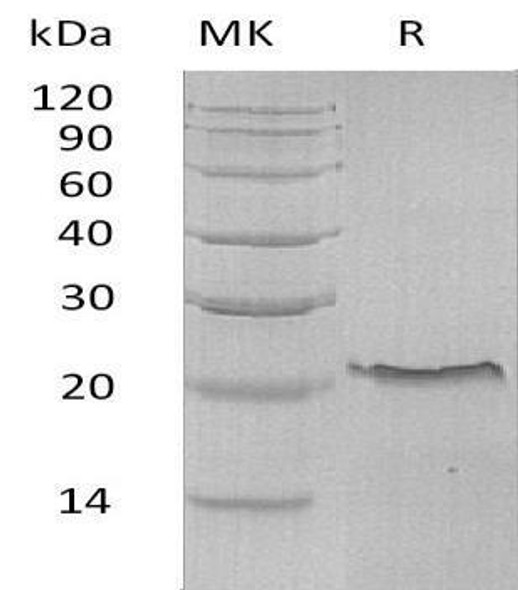Cytokines Recombinant Proteins
Human TNFR Recombinant Protein (RPPB1007)
- SKU:
- RPPB1007
- Product Type:
- Recombinant Protein
- Species:
- Human
- Uniprot:
- P19438
- Research Area:
- Cytokines
Description
| Product Name: | Human TNFR Recombinant Protein |
| Product Code: | RPPB1007 |
| Size: | 20µg |
| Species: | Human |
| Target: | TNFR |
| Synonyms: | Tumor necrosis factor receptor superfamily member 1A, Tumor necrosis factor receptor 1, Tumor necrosis factor receptor type I, TNF-R1, TNF-RI, TNFR-I, p60, p55, CD120a, TNFRSF1A, TNFAR, TNFR1, FPF, TBP1, TNF-R, p55-R, TNFR55, TNFR60, TNF-R-I, TNF-R55, MGC19588. |
| Source: | Escherichia Coli |
| Physical Appearance: | Sterile Filtered clear solution. |
| Formulation: | TNFR His Tag protein is supplied in 1xPBS, 50% glycerol. |
| Stability: | Store at 4°C if entire vial will be used within 2-4 weeks. Store, frozen at -20°C for longer periods of time. Please avoid freeze thaw cycles. |
| Purity: | Greater than 95.0% as determined by SDS-PAGE. |
| Amino Acid Sequence: | DSVCPQGKYIHPQNNSICCTKCHKGTYLYNDCPGPGQDTDCRECESGSFTASENHLRHCLSCSKCRKEMGQVEISSCTVDRDTVCGCRKNQYRHYWSENLFQCFNCSLCLNGTVHLSCQEKQNTVCTCHAGFFLRENECVSCSNCKKSLECTKLCLPQIEN |
TNFR1 belongs to the TNF-receptor superfamily. TNFR1 is a receptor for TNFSF2/TNF-alpha and homotrimeric TNFSF1/lymphotoxin-alpha. There are 2 types of soluble TNF receptors: sTNFR-I and sTNFR-II, which act to neutralize the biological activities of TNF alpha and TNF beta. The levels of these soluble receptors seem to increase as a result of shedding of the extracellular domains of the membrane bound receptors. TNF-a, TNFR1 and TNFR2 have roles in cellular differentiation. TNFR1 and TNFR2 function in cell type-specific renal injury.TNFR1 is capable of signaling both cell survival and apoptosis. TNFR1-induced apoptosis requires 2 sequential signaling complexes. TNFR1 is capable of activating NF-kappaB, mediate apoptosis, and function as a regulator of inflammation. Oxidative stress promotes TNFR1 and TNFR2 self-interaction, ligand-independent and enhanced ligand-dependent TNF signaling. TNFR1 contributes to the induction of non-cytocidal TNF effects including anti-viral state and activation of the acid sphingomyelinase. Human TNFR1 has a major region which controls cell surface expression. High levels of soluble TNF receptors are found in the amniotic fluid of pregnant women.Germline mutations of the extracellular domains of TNFR1 are linked to the autosomal dominant periodic fever syndrome. The impaired receptor clearance is believed to be a mechanism of the disease. Familial hibernian fever (FHF) is caused by defects in TNFRSF1A gene.
TNFR Human Recombinant produced in E.Coli is a single, non-glycosylated, Polypeptide chain containing 161 amino acids fragment (41-201) having a molecular weight of 22.68kDa and fused with a 4.5kDa amino-terminal hexahistidine tag. The TNFR His Tag is purified by proprietary chromatographic techniques.
| UniProt Protein Function: | TNF-R1: Receptor for TNFSF2/TNF-alpha and homotrimeric TNFSF1/lymphotoxin-alpha. The adapter molecule FADD recruits caspase-8 to the activated receptor. The resulting death-inducing signaling complex (DISC) performs caspase-8 proteolytic activation which initiates the subsequent cascade of caspases (aspartate- specific cysteine proteases) mediating apoptosis. Contributes to the induction of non-cytocidal TNF effects including anti-viral state and activation of the acid sphingomyelinase. Binding of TNF to the extracellular domain leads to homotrimerization. The aggregated death domains provide a novel molecular interface that interacts specifically with the death domain of TRADD. Various TRADD-interacting proteins such as TRAFS, RIPK1 and possibly FADD, are recruited to the complex by their association with TRADD. This complex activates at least two distinct signaling cascades, apoptosis and NF-kappa-B signaling. Interacts with BAG4, BRE, FEM1B, GRB2, SQSTM1 and TRPC4AP. Interacts with HCV core protein. Interacts with human cytomegalovirus/HHV-5 protein UL138. 3 isoforms of the human protein are produced by alternative splicing. |
| UniProt Protein Details: | Protein type:Receptor, cytokine; Membrane protein, integral Chromosomal Location of Human Ortholog: 12p13.2 Cellular Component: Golgi membrane; extracellular space; cell surface; mitochondrion; integral to plasma membrane; axon; extracellular region; plasma membrane; synapse; nucleus; cytosol; receptor complex; lipid raft Molecular Function:protein binding; tumor necrosis factor receptor activity; protease binding; protein complex binding; tumor necrosis factor binding Biological Process: response to alkaloid; viral reproduction; protein heterooligomerization; response to lipopolysaccharide; tumor necrosis factor-mediated signaling pathway; positive regulation of neuron apoptosis; negative regulation of interleukin-6 production; response to wounding; tetrapyrrole metabolic process; inflammatory response; positive regulation of I-kappaB kinase/NF-kappaB cascade; positive regulation of protein import into nucleus, translocation; cytokine and chemokine mediated signaling pathway; positive regulation of tumor necrosis factor production; response to amino acid stimulus; prostaglandin metabolic process; positive regulation of tyrosine phosphorylation of Stat1 protein; positive regulation of angiogenesis; response to ethanol; induction of apoptosis via death domain receptors; DNA damage response, signal transduction resulting in induction of apoptosis; negative regulation of inflammatory response; defense response to bacterium; response to hypoxia; positive regulation of transcription from RNA polymerase II promoter; positive regulation of inflammatory response; negative regulation of apoptosis Disease: Multiple Sclerosis, Susceptibility To, 5; Periodic Fever, Familial, Autosomal Dominant |
| NCBI Summary: | The protein encoded by this gene is a member of the TNF-receptor superfamily. This protein is one of the major receptors for the tumor necrosis factor-alpha. This receptor can activate NF-kappaB, mediate apoptosis, and function as a regulator of inflammation. Antiapoptotic protein BCL2-associated athanogene 4 (BAG4/SODD) and adaptor proteins TRADD and TRAF2 have been shown to interact with this receptor, and thus play regulatory roles in the signal transduction mediated by the receptor. Germline mutations of the extracellular domains of this receptor were found to be associated with the autosomal dominant periodic fever syndrome. The impaired receptor clearance is thought to be a mechanism of the disease. [provided by RefSeq, Jul 2008] |
| UniProt Code: | P19438 |
| NCBI GenInfo Identifier: | 135959 |
| NCBI Gene ID: | 7132 |
| NCBI Accession: | P19438.1 |
| UniProt Secondary Accession: | P19438,Q9UCA4, A8K4X3, B2RDE4, B3KPQ1, B4DQB7, B4E309 B5M0B5, D3DUR1, |
| UniProt Related Accession: | P19438 |
| Molecular Weight: | 24,194 Da |
| NCBI Full Name: | Tumor necrosis factor receptor superfamily member 1A |
| NCBI Synonym Full Names: | tumor necrosis factor receptor superfamily, member 1A |
| NCBI Official Symbol: | TNFRSF1A�� |
| NCBI Official Synonym Symbols: | FPF; MS5; p55; p60; TBP1; TNF-R; TNFAR; TNFR1; p55-R; CD120a; TNFR55; TNFR60; TNF-R-I; TNF-R55; TNFR1-d2�� |
| NCBI Protein Information: | tumor necrosis factor receptor superfamily member 1A; TNF-R1; TNF-RI; TNFR-I; tumor necrosis factor-alpha receptor; tumor necrosis factor receptor type 1; tumor necrosis factor binding protein 1; tumor necrosis factor receptor 1A isoform beta |
| UniProt Protein Name: | Tumor necrosis factor receptor superfamily member 1A |
| UniProt Synonym Protein Names: | Tumor necrosis factor receptor 1; TNF-R1; Tumor necrosis factor receptor type I; TNF-RI; TNFR-I; p55; p60; CD_antigen: CD120aCleaved into the following 2 chains:Tumor necrosis factor receptor superfamily member 1A, membrane form; Tumor necrosis factor-binding protein 1; TBPI |
| UniProt Gene Name: | TNFRSF1A�� |
| UniProt Entry Name: | TNR1A_HUMAN |






